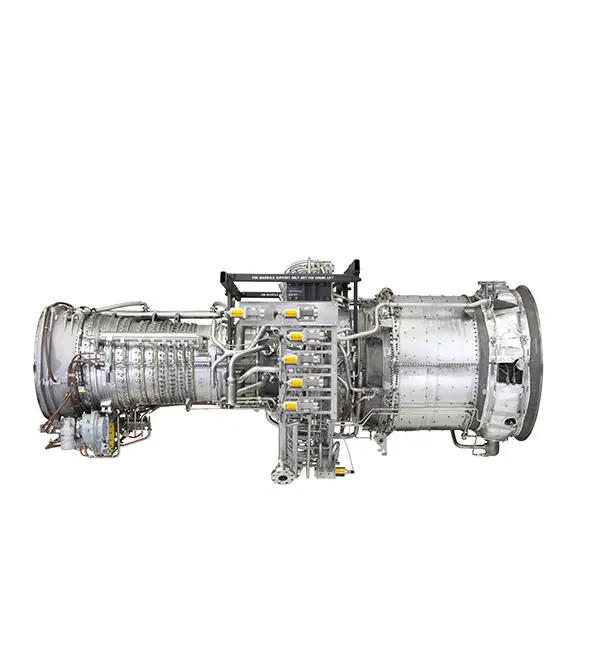In the dynamic world of power generation and mechanical drive systems, aeroderivative gas turbines stand out as a unique and highly versatile technology. Derived from the proven core engines of commercial jet aircraft, these powerplants offer a compelling blend of flexibility, efficiency, and rapid deployment unmatched by their larger, heavy-duty industrial cousins. This article delves deep into the world of aeroderivative gas turbines, exploring their fundamental design, key advantages, operational characteristics, and the diverse applications where they excel.

The core concept behind an aeroderivative gas turbine is elegantly simple: take the high-performance gas generator (core) from a jet engine developed for aviation and adapt it for stationary power or mechanical drive applications on the ground. This lineage bestows several inherent characteristics:
High Power-to-Weight Ratio: Aviation demands extreme power density. Jet engines are marvels of engineering, packing immense power into a compact, lightweight package. This translates directly to aeroderivative gas turbines, making them significantly lighter and more compact than frame-type industrial gas turbines of equivalent output.
Modular Design: Derived from modular jet engines, aeroderivative units are inherently designed in sections (compressor, combustor, turbine). This modularity simplifies maintenance (often allowing module swaps instead of lengthy on-site overhauls) and facilitates transportation and installation.
Advanced Materials and Aerodynamics: Leveraging decades of aerospace R&D investment, aeroderivative gas turbines incorporate cutting-edge materials (like single-crystal turbine blades and advanced alloys) and sophisticated aerodynamic designs optimized for maximum efficiency and performance under demanding conditions.
This aviation heritage is the bedrock upon which the specific advantages of aeroderivative gas turbine technology are built.
One of the most critical advantages of aeroderivative gas turbines is their exceptional operational flexibility, particularly their speed of response:
Rapid Start-Up and Shutdown: Unlike large industrial turbines that can take 30 minutes or more to reach full load, a typical aeroderivative gas turbine can go from cold iron to full power in under 10 minutes, often within 5 minutes. Some models boast "black start" capability, meaning they can start without external power, crucial for grid restoration.
Excellent Load-Following Capability: Aeroderivative units can rapidly ramp power output up and down, making them ideal for applications where demand fluctuates significantly. They can adjust load at rates exceeding 30-50 MW per minute, providing critical grid stability services like frequency regulation.
High Part-Load Efficiency: While peak efficiency is vital, many applications require operation at partial loads. Aeroderivative gas turbines generally maintain higher efficiency across a broader operating range compared to many large simple-cycle industrial turbines.
This agility makes aeroderivative gas turbines indispensable for peak shaving (supplying power during short periods of high demand), grid balancing (compensating for the intermittency of renewables like wind and solar), and backup/emergency power where immediate response is paramount.
Maintenance is a significant operational cost factor. The design philosophy of aeroderivative gas turbines offers distinct advantages:
Modular Maintenance: As mentioned, the modular construction allows for the removal and replacement of entire engine sections (like the gas generator) on-site. This "engine exchange" approach minimizes downtime dramatically – often completed within days – compared to the weeks or months required for major overhauls of large industrial turbines. The replaced module is then refurbished off-site in a controlled environment.
Condition-Based Monitoring (CBM): Aeroderivative gas turbines are heavily instrumented, leveraging aerospace-grade sensors and monitoring systems. Advanced diagnostics allow for highly sophisticated Condition-Based Maintenance (CBM), where maintenance is performed based on the actual health and performance of the machine, optimizing intervals and reducing unnecessary downtime.
Predictable Costs & Intervals: Maintenance costs and schedules for aeroderivative units are often more predictable than large frame machines due to the standardized module exchange process and extensive operational data from aviation derivatives. Operators can plan outages and budgets with greater certainty.
This approach translates directly to higher availability and lower life-cycle maintenance costs, particularly for applications requiring high operational readiness.
In an era demanding cleaner energy solutions, aeroderivative gas turbines offer strong environmental credentials:
High Simple-Cycle Efficiency: Due to their advanced aerodynamic design and high operating temperatures (inherited from jet engines), modern aeroderivative gas turbines achieve some of the highest simple-cycle thermal efficiencies in the gas turbine world, often exceeding 40% and approaching 45% for larger models. This means more electricity or mechanical power is generated per unit of fuel consumed, directly reducing fuel costs and CO2 emissions per MWh produced.
Lower Emissions Intensity: The high efficiency inherently leads to lower CO2 emissions per unit of output. Furthermore, aeroderivative combustors, benefiting from aerospace low-emission combustion technology (like Dry Low Emissions - DLE), achieve remarkably low levels of nitrogen oxides (NOx) and carbon monoxide (CO), frequently meeting the strictest global environmental regulations (e.g., below 15 ppmvd NOx @ 15% O2, sometimes below 10 ppmvd).
Fuel Flexibility (Including Hydrogen Blending): While primarily designed for natural gas or liquid distillate fuels, many aeroderivative gas turbines can accommodate significant blends of hydrogen with natural gas. This positions them as potential transition assets as the energy sector moves towards decarbonization, leveraging existing infrastructure while reducing carbon footprint. Some models are undergoing tests for 100% hydrogen operation.
The combination of high efficiency and advanced combustion technology makes the aeroderivative gas turbine an environmentally responsible choice for power generation and mechanical drive.
The unique blend of advantages – compactness, fast start, high efficiency, flexible operation, and rapid maintenance – makes aeroderivative gas turbines the preferred solution across numerous sectors:
Peaking Power Plants: Their rapid start capability and high efficiency, even for short durations, make them ideal for meeting peak electricity demand spikes. They can be deployed quickly at strategic grid locations.
Combined Heat and Power (CHP) / Cogeneration: The high exhaust heat quality (temperature and flow) from aeroderivative units is perfect for CHP applications. This waste heat can be used for industrial processes, district heating, or absorption chilling, pushing overall system efficiency (electrical + thermal) to 70-80% or higher.
Mechanical Drive: In the oil and gas industry, aeroderivative gas turbines are widely used to drive compressors for natural gas pipelines (both transmission and storage) and pumps for liquid pipelines. Their compact size is advantageous for offshore platforms and remote locations. They also drive compressors in LNG liquefaction trains.
Grid Support Services: Their exceptional load-following speed and black-start capability make them invaluable for providing ancillary services to the grid, such as frequency regulation, spinning reserve, and voltage support, especially crucial with increasing renewable penetration.
Marine Propulsion and Power: Naval vessels and high-speed ferries utilize aeroderivative gas turbines for their high power density and rapid acceleration. They also provide onboard power.
Industrial Power & Backup: Manufacturing facilities requiring reliable, high-quality power, data centers needing critical backup, and remote mining operations benefit from the robustness and fast start of aeroderivative units.
Renewable Integration: As mentioned, their flexibility is key to balancing grids with high shares of variable renewable energy (wind and solar), providing power when the sun isn't shining or the wind isn't blowing.
Major manufacturers like GE Vernova (LM series), Siemens Energy (industrial Trent, industrial RB211), Kawasaki (M1A, M7A), and Mitsubishi Power (from acquired PWPS FT8®) offer robust aeroderivative gas turbine lines covering a wide power range (from a few MW to over 100MW per unit), ensuring a solution exists for almost any application demanding flexibility and performance.
Aeroderivative gas turbines represent a powerful convergence of aerospace innovation and industrial power needs. Their derivation from jet engines grants them unparalleled speed, flexibility, compactness, and high efficiency in simple-cycle operation. These attributes make them uniquely suited for critical applications where rapid response, high availability, operational agility, and environmental performance are paramount – from keeping the lights on during peak demand and balancing renewable energy grids to driving critical compressors in the oil and gas sector and providing efficient combined heat and power.
As the energy transition progresses, demanding more flexible and efficient generation assets to complement renewables, the role of aeroderivative gas turbine technology is set to remain vital. Their ongoing evolution, including increasing fuel flexibility towards hydrogen, ensures they will continue to be a cornerstone of reliable, efficient, and increasingly sustainable power generation and mechanical drive systems for decades to come.
 Gas Turbine
Gas Turbine
 Aircraft parts
Aircraft parts